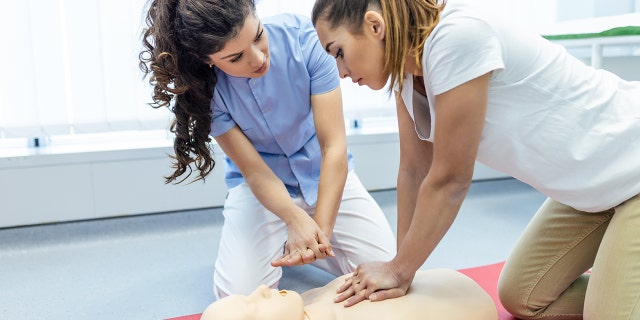Fewer than 40% of out-of-hospital cardiac arrest patients receive CPR before EMS teams arrive, according to the American Heart Association. Even fewer patients are treated with an automated external defibrillator or AED.
New initiatives and partnerships are working to change that, with the goal of doubling the survival rate for heart attacks.
“The idea is to ensure that lifesaving policies are in place at the high school level to make sure that our kids, if they suffer sudden cardiac arrest, have the best possible chances of success,” said Jeff Miller, the NFL’s executive vice president for health and safety innovation.
The NFL and other professional sports leagues are working with the Red Cross and the American Heart Association to promote their Smart Heart Coalition.

An instructor (left) explains CPR (cardiopulmonary resuscitation) training as a student practices the medical procedure on a CPR doll in class. (iStock)
When Buffalo Bills safety Damar Hamlin collapsed during a live Monday Night Football game about six months ago, his team’s doctors were prepared.
“The people were in place; they were practiced,” said Miller. “They had trained their emergency action plan. They knew to take Damar to a level one trauma center when he was evacuated from the field. They had the device there and they knew what to do with it.”
HELP DESPERATELY NEEDED: AMERICAN HEART ASSOCIATION LAUNCHES ‘NATION OF LIFESAVERS’ PROGRAM
Every year, an estimated 350,000 people experience a heart attack outside the hospital. One in 300 kids has an undetected heart condition.
“It’s grants that would enable communities and athletic facilities to get access,” Sen. Peter Welch (D-Vermont) said.
Welch said a reaction plan is important, and a quick response helped save his brother’s life.
“My brother was playing basketball and he collapsed. They had, right there at this gym, a defibrillator,” Welch said.
“The chances of a person surviving this goes up from one out of 10 to three out of 10 if someone’s able to start CPR. It probably goes up to seven out of 10 if we have an AED available as well,” Marshall said.
“I’m committed to getting them across the country in the right locations, but also figuring out everyone should have some type of an app downloaded that could show us those locations.”
Medstar Health in Washington, D.C., is partnering with professional athletes from the Washington Capitals, Mystics and Wizards to demonstrate how to perform CPR and how to use an AED.
CLICK HERE TO SIGN UP FOR OUR HEALTH NEWSLETTER
“Black communities, as well as Hispanic communities, sometimes don’t have as high rates of bystander CPR. And so that’s something that we want to highlight, that this is something that’s accessible to everybody,” Dr. Koo said.
CPR training no longer includes mouth-to-mouth resuscitation. The American Heart Association also says that hands-only CPR can really make a difference.
“We do intend at the AHA to create a ‘Nation of Lifesavers’ and we encourage everyone to learn CPR,” Brown said. “I think that CPR and AED training should be part of everyone’s summer safety plan.”
You can watch Medstar’s videos at MedStarHealth.org/CPR.
If you are interested in getting CPR-certified or learning to use an AED, you can find a class in your area at CPR.heart.org.

